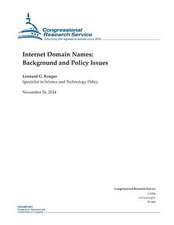Semantic Web: Implications for Technologies and Business Practices
Editat de Michael Workmanen Limba Engleză Hardback – 8 sep 2015
| Toate formatele și edițiile | Preț | Express |
|---|---|---|
| Paperback (1) | 818.87 lei 6-8 săpt. | |
| Springer International Publishing – 23 aug 2016 | 818.87 lei 6-8 săpt. | |
| Hardback (1) | 633.00 lei 6-8 săpt. | |
| Springer International Publishing – 8 sep 2015 | 633.00 lei 6-8 săpt. |
Preț: 633.00 lei
Preț vechi: 744.71 lei
-15% Nou
Puncte Express: 950
Preț estimativ în valută:
121.21€ • 125.03$ • 100.46£
121.21€ • 125.03$ • 100.46£
Carte tipărită la comandă
Livrare economică 20 februarie-06 martie
Preluare comenzi: 021 569.72.76
Specificații
ISBN-13: 9783319166575
ISBN-10: 3319166573
Pagini: 421
Ilustrații: X, 229 p.
Dimensiuni: 155 x 235 x 20 mm
Greutate: 0.51 kg
Ediția:1st ed. 2016
Editura: Springer International Publishing
Colecția Springer
Locul publicării:Cham, Switzerland
ISBN-10: 3319166573
Pagini: 421
Ilustrații: X, 229 p.
Dimensiuni: 155 x 235 x 20 mm
Greutate: 0.51 kg
Ediția:1st ed. 2016
Editura: Springer International Publishing
Colecția Springer
Locul publicării:Cham, Switzerland
Public țintă
ResearchCuprins
Semantic cognition and the ontological to epistemic transformation: Using technologies to facilitate understanding.- Using Symbols for Semantic Representations: A Pilot Study of Clinician Opinions of a Web 3.0 Medical Application.- Emerging Semantic-Based Applications.- Semantics: Revolutionary Breakthrough Or Just Another Way of Doing Things?.- Unnatural Language Processing: Characterizing the Challenges in Translating Natural Language Semantics into Ontology Semantics.- The Lexical Bridge: A Methodology for Bridging the Semantic Gaps between a Natural Language and an Ontology.- Reliable Semantic Systems For Decision Making: Defining A Business Rules Ontology For A Survey Decision System.- University Ontology: A Case study at Ahlia University.- Semantic Enrichment of Event Stream for Semantic Situation Awareness.- Semantic Web and Business:Reaching a tipping point?.
Notă biografică
Michael D. Workman, Ph.D. is a Professor of Computer Information Systems and Human Factors with the College of Engineering, School of Computing at the Florida Institute of Technology.
Textul de pe ultima copertă
This book examines recent developments in semantic systems that can respond to situations and environments and events. The contributors to this book cover how to design, implement, and utilize disruptive technologies from the semantic and Web 3.0 arena. The editor and the contributors discuss two fundamental sets of disruptive technologies: the development of semantic technologies including description logics, ontologies, and agent frameworks; and the development of semantic information rendering including graphical forms of displays of high-density time-sensitive data to improve situational awareness. Beyond practical illustrations of emerging technologies, the goal of this book is to help readers learn about managing information resources in new ways and reinforcing the learning as they read on.
· Examines the contrast of competing paradigms and approaches to problem solving and decision-making using technology tools and techniques
· Covers how to use semantic principles and user-centered designs to improve decision-making and problem solving
· Discusses organization-wide information systems that align technical with business needs
· Examines the contrast of competing paradigms and approaches to problem solving and decision-making using technology tools and techniques
· Covers how to use semantic principles and user-centered designs to improve decision-making and problem solving
· Discusses organization-wide information systems that align technical with business needs
Caracteristici
Examines the contrast of competing paradigms and approaches to problem-solving and decision-making using technology tools and techniques Covers how to use Object-Oriented and semantic principles and user-centered designs to improve decision-making and problem solving Discusses organization-wide information systems that align technical with business needs Includes supplementary material: sn.pub/extras

























